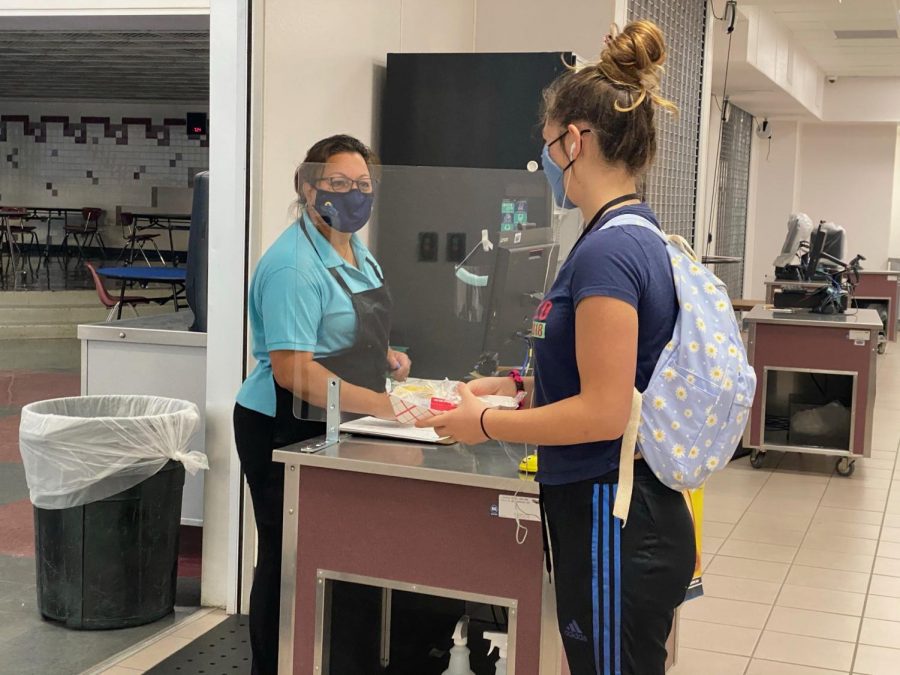Walking away from à la cartes
DM, SUSD offer free ‘grab’n’go’ school meals to all students
STARTING THE DAY WELL-FED: After receiving a free breakfast, Sadie Lattanzio (10) passes by cafeteria manager Eva Youssef. Lattanzio receives meals “every single day,” she said, for “both breakfast and lunch.” Breakfasts are served in the cafeteria, somewhat similar to how they would typically be served, but lunches are served either by the exitway to the busses or in the cafeteria, both in a grab’n’go fashion.
November 12, 2020
Students used to eat lunch at school. Not anymore.
Most students used to pay for their meals. Not anymore.
And students used to have several choices for meals. Once again, not anymore.
This school year, the meal system is completely different.
“It’s just basically, ‘Here’s your option; grab it and go,’” said Patti Bilbrey, Director of Nutrition Services for SUSD.
Because of federal funding authorized by the United States Department of Agriculture, school meals are currently free, and students are receiving meals both before school starts and as students exit DM at the end of the school day.
Breakfasts are served in the cafeteria, and lunches are served both in the cafeteria and at the school exit near the service drive. Currently, there is one primary food choice per meal.
“We’ve got to hurry up and get kids fed super fast,” Bilbrey said, so “we had to limit the choices.”
DM is able to serve meals quickly because the meals are free, which eliminates the need for payment. Free meals also resolve some safety concerns because there are less shared touchpoints.
Once the option to pay for extra meal items is added, payment will become an issue. Bilbrey said payment using student IDs most likely will be encouraged because that can be done contactless.
But there are other safety concerns.
“Our staff feels pretty secure, and I think it is because we have been doing this since March,” Bilbrey said.
However, because of mask supply issues during the spring, the nutrition staff did not have masks while distributing meals for the first several weeks of online learning. “Our first masks were actually made by a teacher at Saguaro,” Bilbrey said.
For safety purposes, school meals are prepackaged, and each item is individually bagged, as well.
“We have to bag everything,” said Eva Youssef, who is in charge of meals at DM. She also tries to eliminate surface transmission, which she says is a major worry for her.
“We are making about 200 lunches every day,” Youssef said. “We used to do about maybe 350 to 400 before.”

Youssef said she would like to add another pickup spot upstairs, by the 7000s building, which would increase the number of students who receive school lunches. Many students do not receive lunches because their last class is in the 7000s building, she added, and time constraints prohibit them from walking to the cafeteria and then to their bus.
At the existing two pick-up locations, the meals rotate each day.
“That’s definitely better than not having any choice” of meals, said junior Josh Page, but having “choices every day would be better.”
Page said that he hopes more choices are added in January, once school returns after winter break.
“The main course can be a little bit iffy sometimes, with the meat,” said sophomore Sadie Lattanzio, “but other than that, it’s pretty good.” Lattanzio said that the vegetables were quality food, though she has no way to compare her experiences at DM to anywhere else.
“This is the first school that I’ve actually ever gotten a lunch at,” Lattanzio said.
She also said that there are no unresolved safety concerns involving school meals. Safety procedures, therefore, are making the school meal system quite abnormal.
“I think everyone would like to go back to normal,” said DM English teacher Ms. Henry, but she said that normality is neither feasible nor safe.
Ms. Henry said that she considers grab-n-go meals safe given that “everyone wears a mask and no one eats inside.”
Because of these safety concerns, the current school meal system is here to stay.
“When we come back in January, the cafeterias will go back to a little more normal,” Bilbrey said, but in the meantime she hopes to improve the current meal system, partly through student feedback.
“I love hearing from all of our students,” Bilbrey said. “I give that information, believe it or not, to our manufacturers, and I say, ‘This is what we’re hearing from kids.’”



